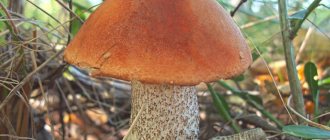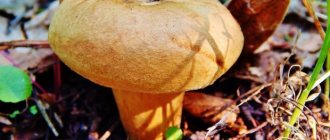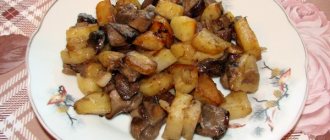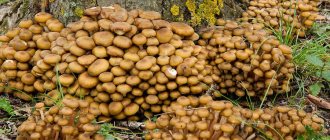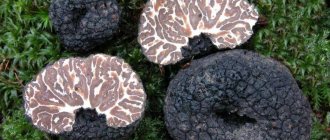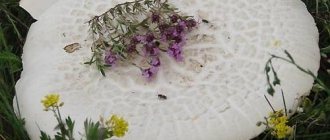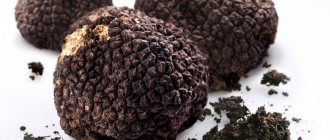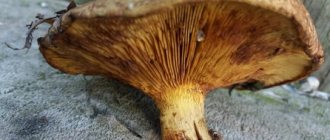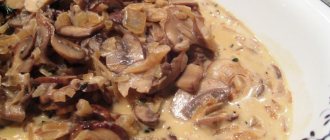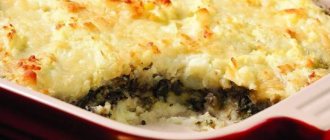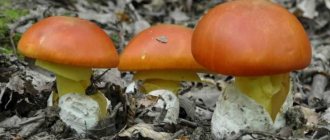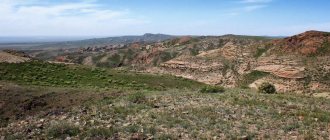Svinukha are common gray-yellow mushrooms. Fierce debate still arises around the question of the possibility of eating them.
Some experts are strongly against their use, while others describe the incredible beneficial properties of mushrooms, believing that they exceed all harmful qualities.
Many housewives have successfully made preparations, claiming that they are tasty and healthy. And no one seemed to have died.
That was until scientists received frightening research results on these mushrooms.
Indeed, people did not die immediately after consuming them. It acts like a time bomb.
Description of pigs
Svinushki belong to the family Svinushkovye from the order Boletaceae. “Dunki” has more than 30 varieties. A description of the appearance of the fruiting bodies of representatives of the genus Paxillus allows us to identify common features:
- The shape of the edge of the cap is wavy; at a certain angle, the cap itself resembles a pig's snout.
- Cap: fleshy and spreading. The shape can be elongated or round. The average size of the cap is 10-15 cm. Some specimens grow up to 35 cm. In young fruiting bodies, the shape of the cap is convex. With age, it levels out, becomes dry and cracks. A depression is formed in the center. After rain, the dry and rough surface becomes sticky. The color of the cap also varies. The pig is found in white, brown, olive, brown and black colors.
- Flesh: firm but soft. It has no smell or taste.
- Leg: solid, short. The color of the stem is the same as the cap or a little lighter.
- Appearance: the fruiting body looks like a milk mushroom.
Thick pig (felt) (lat. Tapinella atrotomentosa)
The most common types of pigs include both thin pigs and thick pigs.
It is a mushroom of the Tapinella family of the order Boletaceae. The mushroom has a cap with a diameter of 5-15 cm, first convex, hemispherical in shape, and later tongue-shaped with a funnel-shaped depression in the center. The surface of the cap is velvety or smooth with a rusty brown color. The edges are turned up. On the underside it has a frequent lamellar layer, cream-colored in young mushrooms and brown in mature ones. The leg is about 7 cm high and up to 3.5 cm in diameter, cylindrical in shape, can be attached centrally or with a lateral offset.
Its surface is velvety, dark brown in color. It is often completely immersed in the substrate. The flesh of the mushroom is whitish-yellow in color, without any particular odor, with a bitter taste.
. It has the ability to swell in the presence of moisture and darkens when broken. Mushroom spore powder is yellow-brown in color. Ammonia colors the flesh of the fat pig a bright lilac color, and potassium hydroxide (KOH) - green-black. Thick pig mushroom is a conditionally edible mushroom. Abroad, it is considered inedible or has unstudied toxic properties. The pulp of these mushrooms contains atromenthin (brown pigment), which acts as an antibiotic and has an antitumor effect, telephoric acid (blue pigment), used to dye wool blue.
Types of mushrooms and their distribution
There are a large number of varieties of pigs. All of them grow in deciduous and coniferous forests, and also love swampy areas. Dunki prefer a temperate climate, so they are often found in Europe, Asia and even North America.
Svinushka is a whole genus of mushrooms. There are 35 species in total. The most common pigs are:
- S. thin: popularly such fruiting bodies are known as poddubniki. They usually germinate at the roots of fallen trees. Their cap is round and slightly wavy. The diameter often reaches 20 cm. The surface color is brown. As the cap ages, it takes on a gray tint. The leg is creamy, short, up to 8 cm long.
- S. alder: common in most European countries. It is distinguished by a funnel-shaped hat, with a diameter of 6-8 cm. This type of pig has a brown cap with a scaly structure and has cracks. The pulp is yellow, there is no smell.
- S. tomentosa (black pigwort): grows only in coniferous forests. This mushroom has a large rounded cap, the edges of which are curved towards the stem. The surface color is brown, brown. A black tint often appears. The leg is brown or brown, with a velvety surface.
- S. ear-shaped: characterized by a small size of the leg (does not exceed 3 cm) and a large fan-shaped cap. Its size can reach 14 cm. The surface of the cap is rough, but becomes smooth with age. The color is light brown. The pulp is yellow and has a pine aroma.
- S. gigantica: this “dunka” has a huge cap size. Diameter – 25-30 cm. Wavy shape, white color. The species is common in Europe. Representatives of the species are found in Russia, as well as the Caucasus.
Mushrooms of the species Paxillus Vernallis are found in the forests of North America. This species is known for its symbiotic relationships with some woody plants: birch and aspen.
Irina Selyutina (Biologist):
- Formally, the species of spring pig was described in 1969 by Roy Watling based on materials collected by Alexander Hanchett Smith in 1967.
- To date, it has been established that the timing of fruiting of the spring and c. thin coincide in time.
- Due to the strong external resemblance to the thin mushroom, which is recognized as poisonous, the mushroom picker must be extremely careful when collecting.
- Research of the genus Paxillus is not currently being carried out on the territory of the Russian Federation, so some mycologists are confident that perhaps they are not encountering the species of spring pig, but that an as yet undescribed species grows on the territory of the country.
The southern countries of Europe are suffering from the spread of another poisonous mushroom from this genus - ammonia pigwort (Paxillus ammoniavirescens). It can be found not only in forests, but also in city parks and alleys next to coniferous and deciduous trees. Representatives of this species simply occupied Italy, France, Portugal, and Spain. You can also find it in northern Africa. The appearance of the mushroom is similar to other members of the genus. It has a spreading, fleshy cap of beige or olive color with a diameter of up to 15 cm. It is rough around the edges and smooth in the center. The leg is medium, 5-8 cm.
Where does it grow and when is it found?
Pigs are found in all temperate regions. They are found in deciduous and coniferous forests. They grow on the edges and clearings, along the edges of marshy areas. They can also grow on the roots of trees that are uprooted. Mushrooms begin to grow in July, and the last mushrooms can be found in the first ten days of October. Reproduction of pigs occurs with the help of spores. Svinushka is a type of mushroom from the Svinushka family. About three decades ago it was listed as a conditionally edible mushroom, but currently it is included in the list of poisonous ones.
Pig has many names that are used in certain areas of our country. The most common ones include: cowshed, dunka, pig farm and some others. The pigweed can be found almost everywhere; it prefers to grow in deciduous or coniferous forests. Favorite places of growth are forest edges next to clearings and the outskirts of swamps. Most often, a cowshed can be found where birches, oaks and shrubs grow.
Where does the pig grow and when is it found?
Often svinushka or dunka grows on uprooted tree roots. A distinctive feature of the mushroom is that it very rarely grows alone. More often it can be found in small groups. The pig loves moisture, including moist soil, and is found in the summer-autumn period, from July to October. Pigweed is characterized by abundant and frequent fruiting.
Interesting read: Doubles again
Is piggyback edible?
Svinushka belongs to the poisonous species of mushrooms
To beginning mushroom pickers, pig mushrooms often seem similar to other edible types of mushrooms. These poisonous representatives of the kingdom Mushrooms grow in the same conditions as edible fruiting bodies.
"Dunka" was banned from being collected in 1993 due to a series of poisonings. The first known case of human death dates back to 1944 (Germany), when mycologist J. Sheffer tasted pig mushrooms. He had severe abdominal pain, vomiting and diarrhea. Schaeffer died 17 days after the meal.
The mushroom is inedible. The harm from its use is as follows:
- Svinushka mushrooms contain dangerous toxins - lectins, the concentration of which remains high even after prolonged heat treatment of the fruiting bodies.
- Some varieties of the mushroom contain the poison muscarine, the toxicity of which is comparable to the poison of the red fly agaric.
- The product contains specific antigens, which, when they enter the body, destroy the cell membranes of the mucous membrane of internal organs. The result of consuming such fruiting bodies is almost unpredictable. Anemia, nephropathy or renal failure may develop.
- The pig mushroom contains chemical compounds based on heavy metals, as well as radioactive particles.
Svinushka is a poisonous mushroom; even its accidental consumption leads to allergic reactions, disruption of the functioning of internal organs and systems, severe poisoning and death. When you see a place where such a mushroom grows, it is better to avoid it. If in doubt, the find should be shown to an experienced mushroom picker, who will tell you whether these are false fruiting bodies or not.
What could be the consequences?
Old grown pigs can accumulate toxic substances. Scientists have also found that the pig mushroom is capable of producing muscarine, a toxic substance similar in characteristics to the red fly agaric. Muscarine itself does not disintegrate when heated and can accumulate in the pig in quantities dangerous to humans.
As a result of a laboratory study of the chemical composition of mushrooms, substances were found in them that can cause blood diseases in humans. In addition, analyzes revealed that pig mushrooms are more adapted than other mushrooms to absorb and accumulate accumulations of heavy metals (lead, cadmium, mercury) contained in industrial waste, as well as in car exhaust gases. This is what a seemingly harmless pig mushroom might look like. The photo is shown below.
Among other things, scientists have proven that eating pig can cause a rare type of allergy, in which there is an excessive release of immune bodies in the human body. Immunoglobulin type G is produced in the blood. As a result, anaphylactic shock can begin, sometimes leading to death. And now it makes sense to think about whether it’s worth eating pig mushrooms? The benefits and harms from them can be absolutely versatile.
Types and their descriptions with photos
Mushrooms consist of eight species of mushrooms. Some of them are not very common:
- Ear-shaped. It looks like an oyster mushroom and grows on the trunks of coniferous trees, attached to them with a leg or a shoot from the cap. The color is olive, yellow or brown, the plates are light. The diameter of the cap is in the range of 2-8 cm. Growth time is late summer and autumn.
- Scaly. A rare species with a cap up to 8 cm and a stalk 4-8 cm. The cap is yellowish with large gray scales. The identification mark is the proximity of alder, because only with it does it form mycorrhiza. Fruits in the second half of summer.
Most often there are two types of cowshed: thick, which is still eaten, and thin, which is dangerous to human health and life. It is imperative to distinguish them. Photos can additionally help with this; they are even recommended to take them with you into the forest and compare them there.
Conditionally edible
Fat pig belongs to a group that is characterized by very low taste and has no value as a source of useful components. In foreign literature it appears as inedible or with unstudied properties.
The distinctive features of the fat pig are the slow darkening of the cut, a short and thick velvety leg of a dark brown or black color, which has been compared to a cigar. The cap can reach 25 cm in diameter, velvety to the touch, brown or pistachio, with spots.
The cap can reach 25 cm in diameter, velvety to the touch, brown or pistachio, with spots.
at
Dangerous
The thin pig has a fleshy cap with curled edges and a funnel in the center. Olive color, darkens with age.
The size of the cap is usually in the range of 12-15 cm; it is very rare to find a 20-centimeter one. She herself is fleshy and thick. At a young age it is light and dome-shaped, over time it changes shape to flat and even slightly curved towards the center, and the color darkens.
The range of colors is from light gray to rich olive. The edges of the cap are wavy, the surface is rough and fluffy, although if there is a lot of moisture around, it becomes glossy, slippery and sticky.
Cowshed
The leg is also small and smooth; it can reach a maximum of 9 cm in length and only 2 cm in width. The color is the same as the hat. A characteristic feature of the barn is that the flesh inside is light yellow, but when broken or cut it quickly darkens to brown.
Period and rules for collecting edible pigs
If mushroom pickers, despite not very flattering characteristics, still collect a barn, then you need to adhere to some rules:
- You should go on a “quiet hunt” far deep into the forest, moving as far away as possible from highways and industrial buildings of factories - this will reduce the chances of collecting harmful chemicals for dinner;
Collection of pigs - take only young fruiting bodies, old ones accumulate more of these compounds over time;
- do not eat large portions, mushrooms are, in principle, quite heavy food, they should play the role of a savory addition in the plate, and not the main dish or side dish;
- prepare dunki, scrupulously following all the rules: start cooking as early as possible, wash thoroughly, cook for a long time in several stages, draining the broth each time, do not store the finished dish for more than a few hours.
The time for collecting pork is the second half of summer and autumn.
Differences between thick mushrooms and thin mushrooms and other poisonous mushrooms
The two most common pigs differ quite noticeably from each other in the rate of darkening of the flesh when broken and the leg, namely its color and thickness. It is convenient to compare this from the photos posted above. Barnyard mushrooms have no obvious resemblance to other poisonous mushrooms.
How to cook mushroom soup with tremors
You can make soup not only from noble mushrooms. Volnushki are no less tasty as a first course. They cook very quickly, the soup turns out hearty and flavorful.
- Mushrooms – 0.4 kg.
- Potatoes – 4 tubers.
- Water – 2 liters.
- Onion – ½ head.
- Carrot.
- Oil, salt, dill, pepper.
- Soak the volushki, drain the infusion, cut into strips.
- Fry diced onion in a frying pan. Next, add the grated carrots. Fry until light golden brown.
- Add chopped mushrooms to vegetables. Continue roasting for 15 minutes.
- At the same time, bring water to a boil in a saucepan. Place potatoes cut into soup strips into boiling water.
- When it is almost ready, transfer the contents of the pan into the pan. Salt and add pepper.
- Cook for another 10 minutes, without letting the soup boil too much. To serve, place chopped herbs on plates.
What do pig mushrooms look like and where are they collected?
Pig mushrooms are called differently: matryoshka, cowshed, fatty or filly. The traditional name comes from the cap's resemblance to a pig's ear. The origin of the remaining folk names is unknown.
Externally, pigfish can easily be confused with valuu or milk mushroom. She has a short thick leg and a fleshy round cap. In young specimens it is convex, but with age it becomes concave and wavy along the edge. Color varies from olive to red-brown. Its intensity depends on the age of the mushroom.
Pigs are found everywhere, in deciduous and coniferous forests, and can sometimes grow even within the city. They can grow either singly or in small groups. Prefers wet or marshy areas.
Features of the mushroom
Until the 90s of the last century, pig mushrooms were classified as conditionally edible mushrooms. Modern scientists have proven that eating them is harmful.
Important! Substances that can reduce the number of red blood cells in the blood have been found in the pulp of the mushroom. In addition, pigs can cause serious poisoning, in some cases fatal.
The classification of pig mushrooms as poisonous mushrooms is explained by some features of the species:
- Mushrooms contain a special antigen, due to which consumption of fried or boiled pulp provokes the production of antibodies by the human immune system.
- The rate of antibody formation depends on the individual characteristics of the organism. For some they provoke rapid poisoning and allergic shock, for others they accumulate in the body for a long time.
- Toxins accumulated in the body impair kidney function, and symptoms of the disease may not appear until several years later. The increased content of toxins causes acute renal failure, which often ends in death.
Those who still dare to collect pig mushrooms should remember that this mushroom is able to survive even in a very polluted environment. It is for this reason that pigs often grow on city lawns and even in environmentally unfavorable regions. In addition, fly larvae and other insects often lay in the pulp of the mushroom.
How can this mushroom be dangerous?
The main danger of pork is that the toxins it contains do not lose their properties even after prolonged heat treatment.
The pulp of this mushroom contains a special antigen. It binds to human cell membrane structures. As a result, the immune system considers them hostile and begins to attack such cells. This leads to destruction of red blood cells and subsequent kidney failure.
In addition, pigs grow almost everywhere, including in places with poor ecology. Heavy metals and radioactive isotopes accumulate in their pulp, causing serious poisoning.
What could be the consequences?
Pigs are dangerous in any form. When eaten fresh, they quickly cause digestive upset, the intensity of which depends on how many mushrooms were eaten. But even if you pour hot marinade over the mushrooms and roll them into a jar, the toxins from the pulp will not disappear and over time can seriously affect your health.
Toxic properties of the mushroom
The antigen contained in the pulp causes an autoimmune reaction. It is expressed in the fact that cells of the immune system attack red blood cells.
Important! The effect of the antigen is manifested by repeated consumption of mushrooms. Some people develop an autoimmune reaction after years of eating pork.
Symptoms appear fairly quickly. First, abdominal pain, vomiting and diarrhea appear. Further, the volume of blood and urine decreases, and the level of hemoglobin drops. Over time, this leads to serious complications, including acute renal and respiratory failure.
It is important to remember that today there is no antidote for pig poisoning. The patient is prescribed maintenance therapy. This includes regular blood tests, adjusting fluid and electrolyte balance, and supporting kidney function.
Description of species
There are several types of pigs. Some of them are clearly poisonous, others can be edible with certain heat treatment.
Thick pig (felt)
Until recently, this particular variety was considered suitable for human consumption. The only option to prepare felt pork is to salt or marinate it. In any other form, the pulp is too hard.
Important! Modern scientists do not recommend eating this mushroom because of dangerous toxins that can cause significant harm to the body.
Externally, the mushroom looks like this:
- The cap is large, up to 20 cm in diameter. The edges are folded inward;
- in young specimens the cap has a regular rounded shape, but with age it becomes disproportionate;
- the skin is velvety, brown or olive-brown;
- the pulp is watery, yellowish, and has no distinct odor;
- the leg is short, brown or olive;
- under the cap there are light yellow plates. When pressed they turn brown.
In the past, felt pigs were partly consumed as food. Some mushroom pickers still believe that young specimens can be cooked: salted and canned. But even if you peel the mushrooms, wash off all the debris from their surface and cook them, the flesh will remain bitter and potentially harmful to health.
Thin pig
Another dubious variety. The ripening season for fruiting bodies occurs in late summer and autumn. Found in coniferous and deciduous forests.
Important! Previously, thin pigs were considered edible. But in 1944, German mycologist Julius Schaeffer died from eating these mushrooms, after which they began to be considered deadly.
The external differences of the mushroom are:
- the cap is olive-brown (in young mushrooms) and rusty-brown with a gray coating - in old ones. Diameter from 12 to 20 cm;
- the pulp is dense, pale yellow, becoming loose with age;
- the leg is cylindrical, no more than 6 cm in height;
- under the cap there are wide and sparse plates.
Pig ear-shaped (panus-shaped)
This mushroom is dangerous because it is poisonous and looks similar to the edible oyster mushrooms.
The ear-shaped pig has the following features:
- grows on dead coniferous trees, sometimes it can grow on wood chips;
- the shape of the cap resembles a fan, colored brown or orange;
- there is no stalk, and its role is played by a short lateral process.
This variety of pig has a distinct mushroom smell, but it should not be eaten due to the risk of poisoning.
Other types
There are several more poisonous varieties in the pig family:
- Alder: got its name due to the fact that it grows on the trunks of alder and aspen. The cap has the shape of a concave funnel and is colored yellow or brownish. The pulp is dense, yellowish, without a distinct smell or taste.
- Pigweed Paxillus obscurisporus: found in clearings, forest edges and pastures from early spring until the first autumn frosts. The cap is golden brown, with a raised brim. The leg is no more than 8 cm in height, gray or yellowish in color. It has a pleasant mushroom smell, but is not suitable for human consumption.
The benefits and harms of pigs
For a long time, pig mushrooms were considered conditionally edible mushrooms. They could be eaten salted or after prolonged heat treatment.
Modern scientists have proven that the pulp of these mushrooms contains dangerous toxins. They can accumulate in the body and cause severe poisoning and kidney failure.
But pigs can also be useful. Scientists have discovered that they contain the natural phenolic compound atromenthin. It can cause the death of leukemic cells, so it is used in the fight against blood and bone marrow cancer.
Pig "fat"
This mushroom is also popularly called the fat one. Previous generations ate it salted. The “fat” pig loves to live on the stumps of coniferous trees or on the roots. It appears at the beginning of the summer season and grows until the first snow falls. Pig mushroom has the following description:
Today, the “fat” pig mushroom is considered poisonous. Its pulp, even when salted, is harsh and bitter. Such pigs were prepared and eaten only in years of famine.
Edibility Proponents' Arguments
Svinushka is well known to experienced mushroom pickers and is very popular. The first fruits appear long before other mushrooms and delight with a bountiful harvest until late autumn. Fans of the spring forest delicacy consider them very tasty. The question of whether it is possible to eat pig mushrooms will only bring a smile to fans, because this mushroom is popularly called the edible pig mushroom. You just need to boil it longer, from 20 to 40 minutes, after which you can cook as usual.
Proponents of edibility are not embarrassed by rumors of poisoning with this product. Inexperienced foragers can become poisoned if they place an inedible mushroom mixed with edible ones in a basket, which is quite enough to cause a food reaction. In addition, pig mushrooms are very similar in appearance to other poisonous mushrooms. You should know well what pigs look like so as not to confuse them, and then you can safely prepare delicious dishes from them and diversify your table.
The strongest argument in favor of edibility is that throughout our lives our grandparents loved to cook soup, roasts, and pickles from these mushrooms. The main thing is to know how to cook. Absolutely any product can be poisonous if not prepared correctly.
Volnushki fried with potatoes
A real hit among volnushka dishes, adored by our people. Not a single mushroom feast is complete without fried potatoes with mushrooms.
- Mushrooms – 400 gr.
- Potatoes – 500 gr.
- Onion.
- Sunflower oil 50 - ml.
- Salt pepper.
- Process the volushki, soak, then boil. Cut into strips.
- Place in a frying pan with heated oil. Fry until the mushrooms are browned.
- Fry the onion in a separate pan. Fry until nicely browned.
- Add the chopped potatoes to the onion. Fry until fully cooked.
- Add mushrooms to potatoes, add salt and pepper. Stir the dish well. Cook together for another 5 minutes.
True danger when eaten
Since 1984, pigs have been officially considered inedible. The composition of their pulp, chemical and toxicological properties have been studied and reliably established for many years. Pig mushroom is not only inedible, it is a dangerously poisonous mushroom. As it turned out, its pulp contains a strong poison, muscarine. This poison is so heat-resistant that it cannot be neutralized even after 3 hours of cooking. There is no point in preparing a dish of mushrooms after boiling for several hours; they will turn into mucus. The strength of the effect of this poison on the cellular structure of the human body is twice as strong as the activity of the red fly agaric, which is similar in composition and contained in the pulp. If you eat pork, acute or chronic intoxication will inevitably develop. With a large dose of poison, acute intoxication will appear literally half an hour after eating.
Symptoms of poisoning will first manifest themselves as increased salivation, dizziness, weakness, sweating, a drop in blood pressure, a weakening of the pulse and a decrease in its rhythm. This will be followed by vomiting, abdominal pain, and frequent and loose stools. A significant dose of toxin threatens the rapid development of cerebral and pulmonary edema. If you do not provide emergency medical care to the victim, there is a high probability of death.
Another serious threat to lovers of this dubious forest delicacy was identified relatively recently, just a few years ago. As a result of a large number of biological experiments, it was found that the mushroom pulp contains a very high concentration of an antigen protein that can cause irreversible damage to red blood cells and erythrocytes. Persistent compounds of this specific antigen protein trigger an agglutination reaction, or the gluing of red blood cells. Blood can clot instantly, and blood clots that form in large vessels of the brain and heart muscle can quickly lead to death.
The antigen protein can accumulate in tissues for many years, entering the body in small quantities from time to time. As a result, a person will develop anemia, various thromboses or other diseases that are in no way associated with food poisoning. The cause of death will be sudden myocardial infarction, cerebral stroke or pulmonary vein thrombosis, which are not directly related to food intoxication.
Appetizer of pigs in spicy marinade
Another recipe for a ready-made mushroom appetizer. Fragrant, very tasty. In addition to cinnamon, it is permissible to add star anise, lemon zest, and various types of pepper – pink or allspice – to the marinade. For canning, it is better to take small mushrooms or just the caps.
- Mushrooms – 1.5 kg.
- Table vinegar – 150 ml.
- Salt – 3 large spoons.
- Water – 1.5 liters.
- Garlic – 2 heads.
- Sugar – 3 large spoons.
- Bay leaf – 5 pcs.
- Lemon zest - a small spoon.
- Ground star anise - a couple of pinches.
- Sulfur pepper – 6-10 peas.
- Sunflower oil - 2.5 large spoons in each jar.
- Wash the mushrooms and soak them for 24 hours, changing the water several times. Rinse under running water and place in a saucepan.
- Boil until tender for an hour, remembering to remove the foam. Then fold to get rid of the broth.
- In a separate saucepan, mix water in the amount specified in the recipe, pour in vinegar. Place on the stove. When the mixture boils, add sugar and salt. Add lemon zest, chopped garlic, bay leaf, pepper.
- Transfer the pork to the boiling marinade and simmer for 25 minutes.
- Remove the pan from the burner and cool the contents.
- Place a pinch of star anise at the bottom of the jars and add mushrooms. Fill with marinade. Pour vegetable oil under the lid. Close tightly with nylon lids (first put them in boiling water). Store the snack in the refrigerator.
Recipes and features of cooking fat pigs
Due to the fact that pigs have long been considered completely edible and are now sometimes eaten, many recipes have been preserved.
How to cook until done?
To clean the mushroom as much as possible from harmful substances absorbed during growth, it is soaked in salt water for three days. Then boil for 2-3 hours, draining the broth after five minutes of cooking after each boil. The second option is soaking for a day, then cooking alternately in salt and vinegar water for half an hour.
Frying
The taste of barnyard becomes interesting after frying. To do this, you need to take 700 g of boiled mushrooms, 2 onions, 2 tbsp. l. sour cream, oil for frying and spices to taste: salt, pepper, a couple of bay leaves.
Fried pigs
Before frying, you will have to cook the pork for a long time: you need to spend several hours on this (the methods are described above). And only then the cut fruit bodies are fried for 10 minutes in oil with spices and 5 with sour cream.
Preparation for the winter
Before closing a jar of pigs for the winter, they must be soaked. The recipe is for 1 kg of raw mushrooms (young, medium-sized ones):
- 500 ml vinegar;
- 3 cups olive oil;
- spices: 2-3 medium-sized bay leaves, black pepper, salt, garlic.
Preparing mushrooms
Boil the processed, washed pigs in water and salt for 30 minutes, rinse and cook again in water and vinegar for 20 minutes. Let them drain and fry them in oil and spices, pour into sterile jars, roll up, wrap until completely cool.
How to cook fried volushki
The fastest way to enjoy a delicious dish is to fry them.
- Mushrooms – 500 gr.
- Bulb.
- Butter – 50 gr.
- Pepper, salt.
- Soak and cook the fritters in advance. Place in a colander and wait for the broth to drain.
- Chop the onion into small cubes and fry in a frying pan, adding a piece of butter.
- Cut the mushrooms into pieces. Leave the tiny caps whole; they look delicious on a plate.
- Transfer the slices to the onions and continue frying together for 5-7 minutes. Stir the contents frequently to ensure even cooking.
- Shortly before the end of cooking, season the dish with pepper and salt. If you think that there is not enough oil, add a little sunflower oil.
Effect on the body, consequences of eating thin pork
Until 1993, the mushroom was considered conditionally edible; it was collected and fried, boiled, and salted. After 1993, it was classified as poisonous, but many mushroom pickers, due to habit and their own carelessness, still continue to collect and prepare this toxic “bomb.” The mechanism of its action is partly similar to the effect of radiation exposure: negative consequences most often do not appear immediately, but have a cumulative effect, that is, poisoning by these mushrooms can be chronic. This is probably why people continue to eat pig's ear, naively believing that if alarming symptoms do not appear immediately, then everything is fine. This misconception is very dangerous for several reasons:
- the mushroom contains hemolysin, hemoglutin, lectin, muscarine - toxic substances, while the last two of them are not destroyed by heat treatment;
- toxic and harmful substances that are in the mushroom are not eliminated from the body during life;
- in people suffering from kidney failure, dishes made from thin pigs can cause severe poisoning with a fatal outcome.
Due to the poisonous content of muscarine, pig's ear is compared to fly agarics. The difference is that if you eat fly agaric, symptoms of poisoning and death will occur within 24 hours, while the results of eating pigs will appear much later.
Thin pork causes a strong allergic reaction in the body. As a result of consuming the mushroom, irreversible changes occur in the blood: antibodies to one’s own red blood cells begin to be produced. Red blood cells are destroyed, anemia and kidney failure begin. In the future, a heart attack, stroke or thrombosis may occur.
Thin pigs have strong absorbing properties: they, like a sponge, absorb heavy metal salts, radioactive isotopes of cesium and copper from the environment. Collected near roads, factories, and nuclear power plants, these mushrooms become even more harmful and dangerous. For chronic poisoning, periodic consumption of small amounts of pork ear, for example, in salted form, is sufficient. In the period from 2-3 months to several years, the first health problems may appear.
The above does not mean that the mushroom cannot cause acute poisoning immediately after eating. Children, the elderly, and those who suffer from diseases of the gastrointestinal tract and kidneys are at risk. For them, eating a mushroom dish 30-40 minutes after eating can cause the following symptoms:
- acute pain in the peritoneum;
- diarrhea;
- nausea and vomiting;
- jaundice;
- pallor;
- increased salivation;
- sweating;
- weakness, deterioration of coordination;
- hypotension.
If a large amount of toxin enters the body, then swelling of the brain and lung tissue occurs, resulting in death.
How to pickle volushki without cooking for the winter?
Horseradish leaves, currants, chopped garlic, salt and volushki are placed in a deep container in layers. Next, everything is put under pressure and sent to the refrigerator. Next, the mushrooms are placed in jars, filled with the resulting brine and covered with lids.
Cooking time: 12 days.
Cooking time: 25 min.
Portions – 30.
Ingredients:
- Volnushki – 3 kg.
- Salt – 5 tbsp.
- Horseradish leaves – 3 pcs.
- Black currant leaves – 10 pcs.
- Black peppercorns – 10 pcs.
- Garlic – 6 cloves.
- Dill umbrellas – 6 pcs.
- Bay leaf – 3 pcs.
Cooking process:
Step 1. Take a container in which we will salt the mushrooms and put a horseradish leaf, finely chopped garlic and a couple of currant leaves on the bottom. Sprinkle everything with a little salt.
Step 2. Place a layer of pre-soaked waves on top, caps down. Make a layer no more than 6 centimeters thick.
Step 3. Sprinkle the mushrooms with salt and place horseradish leaves, currants, chopped garlic and dill umbrellas on top.
Step 4. Thus, put all the ingredients into the container.
Step 5. Place the last layer of horseradish leaves and cover everything with a flat plate.
Step 6. We install the oppression on top and send the container with the waves to the refrigerator or cellar. After about 4 days, the mushrooms will give a large amount of juice, so we increase the weight of the load so that the mushrooms are completely covered with brine.
Step 7. After 9-10 days, the mushrooms are ready. We put them in clean jars and fill them with the resulting brine. We close everything with nylon lids and store it in the refrigerator or cellar. We serve the finished appetizer to the table along with the main course. Bon appetit!
Causes of toxicity
Mushrooms contain a poison that affects protein synthesis - dicyclopentanone, which causes severe intoxication of the body. Often ends in death. A lot depends on the individuality of the human body, since the harmful substance is not eliminated, but accumulates in the body, which is extremely dangerous.
The toxin provokes the growth of antibodies, the breakdown of red blood cells occurs, the level of hemoglobin drops, and as a result, hemolytic anemia. Due to the presence of muscarine (a certain poison, which is also present in fly agaric mushrooms, is not broken down during cooking, but remains in the mushrooms), mares are classified as conditionally poisonous mushrooms.
Did you know? Since 1984, thin mushroom has been excluded from the list of edible mushrooms.
English salad with pigs
Ingredients: two hundred and fifty grams of chicken meat, one hundred grams of pickled cucumber, one hundred grams of fresh cucumber, fifty grams of radish, one hundred and fifty grams of celery stalk; two hundred grams of pork, half an onion, one bunch of lettuce, two spoons of mayonnaise, as well as one and a half spoons of lemon juice, one bunch of parsley, half a spoon of sugar, one spoon of mustard, salt to taste.
Preparation
Before cooking pork, you need to clean them, then boil them using the above method. Chicken meat is boiled and cut into strips along with celery. Finely chop the onion, cut the mushrooms into slices and fry in oil. All cucumbers are cut into strips, radishes into thin strips. Parsley is finely chopped. Mix meat, mushrooms, celery, radishes and cucumbers in a bowl. Next, prepare the dressing. To do this, mayonnaise is mixed with lemon juice, mustard and sugar are added.
Lettuce leaves are placed on a large dish, the prepared mixture is poured on top, the dressing is poured over everything and decorated with herbs.
Symptoms of Pork Poisoning
It all depends on the amount of mushrooms consumed and the age of the person. It poses a particular danger to children, pregnant women, older people, and categories of people with weakened bodies. There are three degrees of pig poisoning.
Light
After an hour (maximum - after 6) it is noted:
- heaviness, pain in the stomach;
- lower back pain;
- vomit;
- loose stools (often);
- acute gastroenteritis;
- general weakness due to dehydration;
- coldness of the extremities is noted;
As the symptoms of acute gastroenteritis subside, the patient recovers and is healthy on the sixth day.
Average
In case of repeated consumption of mushrooms or failure to provide assistance with primary signs of intoxication:
- the liver enlarges;
- bilirubin levels increase;
- The level of nitrogen in the blood rises.
We recommend reading a delicious recipe for mushroom soup made from pigs.
Heavy
When consuming raw, poorly heat-treated mushrooms:
- severe exicosis (complete dehydration);
- acute cardiovascular and hepatic-renal failure;
- encephalopathy;
- loss of consciousness;
- hemolysis occurs (destruction of red blood cells) with a decrease in hemoglobin and an increase in bilirubin concentration;
- liver damage;
- development of DIC syndrome.
First aid
It is important to call doctors or take the patient to a medical facility as soon as possible; there is no time to waste!
Before the ambulance arrives, you must:
- Rinse the stomach with plenty of warm water with diluted potassium permanganate or table salt.
- Lay the patient horizontally and do not allow him to move.
- Give sorbent.
- Take an antiallergic pill (Suprastin or Tavegil).
Important! Before the doctors arrive, it is strictly forbidden to give the patient medications for vomiting and diarrhea!
Be sure to tell doctors about the causes of the threatening condition and the treatment measures taken. The patient is hospitalized with subsequent long-term treatment.
You should not take risks and use deadly pigs in cooking. Some people, by sheer luck, were lucky not to get poisoned, but such “luck” is an exception to the rule. It is better to purchase (or reliably distinguish when collecting) proven mushrooms with valuable nutritional qualities - this way you will preserve the health of yourself and your family.
Pie with puff pastry and chicken - delicious recipe
- Chicken fillet – 300 gr.
- Volnushki – 200 gr.
- Egg.
- Onion.
- Garlic cloves - 2 pcs.
- Oil, vegetable - 2 large spoons.
- Puff pastry – 0.5 kg.
- Flour – 2 large spoons.
- Chicken broth – 100 ml.
- Milk - the same amount.
- Butter – 30 gr.
- Pepper, salt.
- Chop the garlic cloves and onion. Fry together in sunflower oil.
- After 10 minutes, add the boiled and chopped mushrooms to the frying pan.
- Separately, fry the chicken fillet, cut into cubes.
- Then melt a piece of butter in a frying pan and add flour. Fry until golden brown.
- Pour in broth and milk. Whisk thoroughly so that there are no lumps left.
- Add mushrooms and chicken to the sauce. Mix the filling again. Adjust the taste for salt and pepper. Simmer at a gentle simmer for about 10 minutes.
- Roll out the puff pastry into a rectangle and divide the sheet into 2 parts.
- Grease a baking dish with oil and place the first sheet on the bottom.
- Place the filling and smooth it out. Cover with the next sheet of dough. Pinch the edges. Grease with yolk.
- Bake at 180 o C, setting the timer for 30 minutes.
Conclusion: can it be eaten?
Everyone should be responsible for their own health and decide whether they can eat a product such as pig mushroom or not.
The mention of grandparents, whose lives fell on harsh years, is completely inappropriate in this case. In conditions of malnutrition, not entirely edible foods could save people from starvation. In extreme conditions, the body is sometimes able to create an antidote and react completely differently than in normal conditions.
Many edible fruits of remarkable quality and taste grow in the forests and fields of our country. There is no point in tasting and eating everything. It makes more sense to simply accept: pig mushroom is an inedible mushroom.
Video
An experienced mushroom picker talks about preparing and marinating barns in the following video:
For several years she worked as a television program editor with leading producers of ornamental plants in Ukraine. At the dacha, of all types of agricultural work, she prefers harvesting, but for this she is ready to regularly weed, pull, shed, water, tie, thin out, etc. I am convinced that the most delicious vegetables and fruits are those grown with your own hands!
Found a mistake? Select the text with the mouse and click:
In Australia, scientists have begun experiments in cloning several varieties of grapes grown in cold regions. Climate warming, which is predicted for the next 50 years, will lead to their disappearance. Australian varieties have excellent characteristics for winemaking and are not susceptible to diseases common in Europe and America.
It is believed that some vegetables and fruits (cucumbers, stem celery, all varieties of cabbage, peppers, apples) have “negative calorie content,” that is, more calories are consumed during digestion than they contain. In fact, only 10-20% of the calories received from food are consumed in the digestive process.
